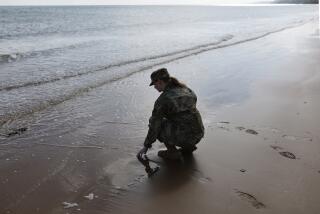Atlantic Wall Lives On in Peaceful Guise : Relics: Many concrete structures are virtually indestructible. They have been made over into homes, cafes, museums, and even a discotheque.
- Share via
CAEN, France — Stretching from Norway to France, Hitler’s Atlantic Wall was a formidable chain of bunkers and artillery batteries. Many remain as haunting relics of an unfinished defense the Allies raced against time to overrun.
Fifty years after World War II, the concrete blockhouses with walls up to 10 feet thick are virtually indestructible or too expensive to tear down. They’ve been turned into vacation homes, restaurants, cafes, arsenals, museums, archives, granaries, a cancer clinic, a yacht club, even a discotheque.
About 1.3 million prisoners and workers were detailed to build 15,000 fortified positions along the 2,400-mile coastline for radar, artillery and 300,000 soldiers, said Remy Desquesnes, a historian at the Caen Memorial and Peace Museum.
The project began in the spring of 1942 and was to be have been completed by May, 1943. But by the D-Day invasion at Normandy on June 6, 1944, only about 10,000 positions stood ready, Desquesnes said.
Rushing to finish the job, the Germans cannibalized France’s infamous Maginot Line, which the Germans avoided at the start of the war by going through Belgium. The network of underground bunkers and tunnels on France’s northeastern border was stripped of cannon, compressors and other equipment.
“It was a race against time,” Desquesnes said. “The more D-Day was delayed, the stronger the wall became.”
In Normandy alone, the wall had 800 firing positions with 3,000 artillery pieces.
Probably the best-known section of the Atlantic Wall is the complex at Pointe du Hoc on a steep Normandy coastal cliff. U.S. Army Rangers stormed it on D-Day but suffered heavy casualties.
At Douvres-La-Delivrande, near Caen, is a former German radar station that is now a museum featuring a tracking room and cramped, submarine-like living quarters. The last crew was driven out by Allied flamethrowers.
Farther down the road toward the coast is a former artillery battery that guarded the entrance to the strategic Orne River, whose Pegasus Bridge was the first seized by the Allies before dawn on D-Day.
The battery, with a coat of white and blue paint, is now Le Surfer discotheque. Inside the small fort, artillery shells have been replaced by glass columns filled with water and bubbles, and a searing rave beat is as loud as gunfire. Sheet metal slickens the dance floor and black rubber matting keeps the barflies from slipping.
Morbid?
“No. People think it’s original,” co-owner Michel Carrasco said as patrons lined up at the door.
The Dutch section of the wall consisted mainly of defensive structures the Dutch had already built before the Nazi invasion in 1940. One bunker is used in The Hague by the government to store archives, another as a wine cellar.
The Atlantic Wall was built with assembly line efficiency, using standardized blueprints, doors, ventilation and other equipment, Desquesnes said.
Some of the strongholds were equipped with enough water, food, medicine and workshops to survive a 30-day siege.
The wall also included about 500,000 obstacles such as tank traps and millions of land mines.
Most of the builders were slave laborers from the Soviet Union but also Czechs, Poles and Jews, Desquesnes said. Workers included geologists, botanists, even artists.
In the end the Atlantic Wall failed. And it had sapped the Nazi war effort, using an estimated 460 million cubic feet of concrete and 3 million tons of steel, Desquesnes said.
“It wasted a lot of the Nazis’ resources,” he said. “The steel used in the blockhouses wasn’t used in naval construction.”
More to Read
Sign up for Essential California
The most important California stories and recommendations in your inbox every morning.
You may occasionally receive promotional content from the Los Angeles Times.








